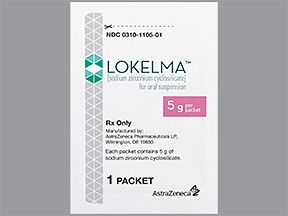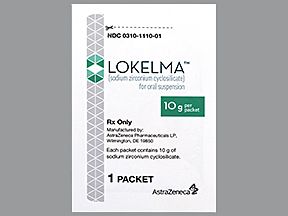Lokelma (sodium zirconium cyclosilicate) is a brand-name drug prescribed for hyperkalemia in adults. Lokelma comes as a powder that you mix to form an oral liquid suspension. You take it one to three times per day.
Lokelma belongs to a drug class called potassium binders. Lokelma isn’t available in a generic version.
Keep reading for specific information about the dosage of Lokelma, including its strengths and how to take the medication. For a comprehensive look at Lokelma, see this article.
Note: This article describes typical dosages for Lokelma provided by the drug’s manufacturer. When taking Lokelma, always follow the dosage prescribed by your doctor.
Read below for recommended dosages of Lokelma and other details about the drug.
Lokelma form
Lokelma comes as a powder in single-use packets. You mix the powder with water to form an oral liquid suspension.
Lokelma strengths
Lokelma comes in two strengths: 5 grams (g) and 10 g.
Typical dosages
Typically, your doctor will prescribe a high dosage to start. A high starting dosage allows the drug to start working more quickly. Then, your doctor will monitor your potassium level to determine whether you need to continue taking Lokelma. With continued treatment, they’ll adjust your dosage over time to reach the amount that maintains the desired potassium level.
The following information describes dosages that are commonly prescribed or recommended. However, be sure to take the dosage your doctor prescribes for you. Your doctor will determine the best dosage to fit your needs.
Dosage for hyperkalemia
The recommended starting dosage is 10 g three times per day. This is the usual dosage for the first 48 hours of Lokelma treatment for hyperkalemia (high potassium levels).
Lokelma’s recommended maintenance dosage is 10 g once per day. However, it can range from 5 g every other day to a maximum dosage of 15 g per day. Your maintenance dose will depend on how much Lokelma you need to maintain your potassium level.
Talk with your doctor if you have questions about your dosage.
Long-term treatment
The length of your Lokelma treatment depends on your potassium level. Sometimes, hyperkalemia goes away within 48 hours of starting the drug. If this happens, your doctor may decide further treatment with Lokelma isn’t needed.
But if your potassium levels remain high, your doctor may recommend continuing treatment. The drug is safe to take long term. So if you and your doctor determine that Lokelma is effective for you, you’ll likely take it long term.
Here are answers to some frequently asked questions about Lokelma and dosage.
How does the dosage of Lokelma compare with the dosage of Kayexalate?
Similar to Lokelma, Kayexalate was a brand-name drug prescribed for hyperkalemia (high potassium levels). Note that Kayexalate has been discontinued and is no longer available in the United States. However, Kayexalate’s active drug (sodium polystyrene sulfonate) is still available as a generic version.
The typically recommended maintenance dosage of Lokelma is 10 grams (g) per day. However, if your doctor prescribes Lokelma, they’ll determine the dosage that’s right for you. For details, see the “Lokelma dosage” section just above. To find out about the dosage of sodium polystyrene sulfonate, talk with your doctor or pharmacist.
Can you mix Lokelma with juice?
No, you should not mix Lokelma with juice. Lokelma should only be mixed with water to form an oral liquid suspension. To learn more, see the “How to take Lokelma” section below.
If you have questions about how to prepare Lokelma, talk with your doctor or pharmacist.
The Lokelma dosage your doctor prescribes will depend on several factors. These include:
- the level of potassium in your blood
- whether you receive hemodialysis (a common type of dialysis)
- other medical conditions you may have
Dosage adjustments
If you receive hemodialysis treatment, your doctor may lower your dosage of Lokelma. Specifically, your doctor may prescribe a low dosage to start. (Typically, doctors prescribe a high dosage to start.) Then, they’ll slowly increase it to reach the amount of Lokelma that’s right for you.
Talk with your doctor to learn more about dosage adjustments.
Lokelma comes as a powder in single-use packets. You mix it with water to form a liquid suspension that you swallow.
To prepare each dose:
- Empty the powder packet into a glass with at least 3 tablespoons of water. (You can use more water if you prefer.)
- Stir the mixture until the powder dissolves.
- Drink it right away.
- If there’s some powder left in the glass, add more water, stir again, and drink right away.
It’s important to only mix Lokelma with water.
For more information on how to take Lokelma, refer to the drug manufacturer’s instructions. You can also talk with your doctor or pharmacist.
Note: If you take any other medications, your doctor may advise taking them at least 2 hours before or 2 hours after your dose of Lokelma. Always follow your doctor’s instructions for taking your medications. Talk with your doctor or pharmacist if you have any questions.
ACCESSIBLE DRUG LABELS AND CONTAINERSSome pharmacies offer labels with large print, braille, or a code you scan with a smartphone to convert text to speech. If your local pharmacy doesn’t have these options, your doctor or pharmacist might be able to recommend a pharmacy that does.
If you miss a dose, take it as soon as you remember. But if it’s almost time for your next dose, skip the missed dose. Then, take your next dose as scheduled.
Do not take two doses at once to make up for a missed dose. This can increase your risk of side effects. You can learn about Lokelma’s side effects in this article.
If you’re not sure whether to take or skip a missed dose, talk with your doctor or pharmacist.
To help make sure that you don’t miss a dose, try using a medication reminder. This can include setting an alarm or putting a note where you’ll see it, such as on your bathroom mirror or bedside table. You could also download a reminder app on your phone.
It’s important that you do not take more Lokelma than your doctor prescribes. For some medications, taking more than the recommended amount may lead to harmful effects or overdose. To learn about side effects of Lokelma, see this article.
If you take more than the recommended amount of Lokelma
Call your doctor right away if you believe you’ve taken too much Lokelma. Another option is to call America’s Poison Centers at 800-222-1222 or use its online tool. If you have severe symptoms, immediately call 911 or your local emergency number, or go to the nearest emergency room.
The dosages in this article are typical dosages provided by the drug’s manufacturer. If your doctor recommends Lokelma for you, they’ll prescribe the dosage that’s right for you. Always follow the dosage that your doctor prescribes.
As with any drug, never change your dosage of Lokelma without your doctor’s recommendation. If you have questions about the dosage of Lokelma that’s best for you, talk with your doctor.
Besides learning about dosage, you may want other information about Lokelma. These additional articles might be helpful:
- More about Lokelma. For information about other aspects of Lokelma, refer to this article.
- Side effects. To learn about side effects of Lokelma, see this article. You can also look at the Lokelma prescribing information.
- Drug comparison. Find out how Lokelma compares with Veltassa.
- Cost. If you’d like information about Lokelma and cost, see this article.
- Details about your condition. Learn more about hyperkalemia (high potassium levels).
Disclaimer: Medical News Today has made every effort to make certain that all information is factually correct, comprehensive, and up to date. However, this article should not be used as a substitute for the knowledge and expertise of a licensed healthcare professional. You should always consult your doctor or another healthcare professional before taking any medication. The drug information contained herein is subject to change and is not intended to cover all possible uses, directions, precautions, warnings, drug interactions, allergic reactions, or adverse effects. The absence of warnings or other information for a given drug does not indicate that the drug or drug combination is safe, effective, or appropriate for all patients or all specific uses.


